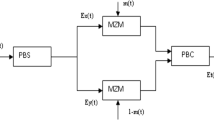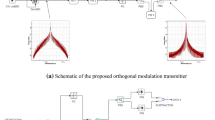Abstract
In this paper, we propose a novel mode division multiplexing (MDM) based FSO transmission system incorporating polarization shift keying (PolSK) to enhance the information carrying capacity of the system. Using numerical simulations, we report the transmission of two independent 40 Gbps information signals using distinct Laguerre Gaussian modes up to an FSO transmission reach of 90 km under the influence of clear environmental conditions using the proposed system. Further, the influence of different environmental conditions such as rain, haze, and fog on the performance of the proposed link using bit error rate as performance metrics has also been investigated in this paper. Also, we report a comparative analysis of PolSK and on–off keying modulation formats in the proposed MDM-FSO link under the same environmental conditions. The simulation results show that under different weather conditions, PolSK based MDM-FSO transmission system demonstrates better performance.






Similar content being viewed by others
References
Singh, J., & Kumar, N. (2013). Performance analysis of different modulation format on free space optical communication system. Optik,124(20), 4651–4654.
Badar, N., & Jha, R. K. (2017). Performance comparison of various modulation schemes over free space optical (FSO) link employing Gamma–Gamma fading model. Optical and Quantum Electronics,49, 192.
Fadhil, H. A., et al. (2013). Optimization of free space optics parameters: An optimum solution for bad weather conditions. Optik-International Journal for Light and Electron Optics,124(19), 3969–3973.
Hammed, N., Mehmood, T., & Qasim, A. (2014). Parametric investigation of different modulation techniques on free space optical systems. In Proceedings of IEEE 12th international conference on frontiers on information technology (pp. 11–15).
Nadeem, L., Saadullah Qazi, M., & Hassam, A. (2017). Performance of FSO links using CSRZ, RZ, and NRZ and effects of atmospheric turbulence. Journal of Optical Communications,39(2), 191–197.
Dayal, N., Singh, P., & Kaur, P. (2017). Long-range cost-effective WDM-FSO system using hybrid optical amplifiers. Wireless Personal Communications,97(4), 0055–6067.
Prabhu, K., Charanya, S., Jain, M., & Guha, D. (2017). BER analysis of SS-WDM based FSO system for vellore weather conditions. Optics Communication,403, 73–80.
Kumar, N., & Teixeira, A. (2016). 10 Gbit/s OFDM based FSO communication system using M-QAM modulation with enhanced detection. Optical and Quantum Electronics,48, 9.
Kaur, G., Srivastava, D., Singh, P., & Parasher, Y. (2019). Development of a novel hybrid PDM/OFDM technique for FSO system and its performance analysis. Optics & Laser Technology,109, 256–262.
Luo, J., Li, J., Sui, Q., Li, Z., & Lu, C. (2016). 40 Gb/s mode-division multiplexed DD-OFDM transmission over standard multi-mode fiber. IEEE Photonics Journal,8(3), 1–7.
Arik, S. O., Kahn, J. M., & Ho, K. (2014). MIMO signal processing for mode-division multiplexing: An overview of channel models and signal processing architectures. IEEE Signal Processing Magazine,31(2), 25–34.
Kasmi, M., Bahloul, F., Lee, Y. S., Oh, K., Mhatli, S., & Attia, R., (2018) Design of hollow optical fiber for mode division multiplexing. In 2018 20th International Conference on Transparent Optical Networks (ICTON), Bucharest (pp. 1–3).
Liu, J., et al. (2018). Mode division multiplexing based on ring core optical fibers. IEEE Journal of Quantum Electronics,54(5), 1–18.
Fazea, Y., & Amphawan, A. (2016). 40Gbit/s MDM-WDM Laguerre–Gaussian mode with equalization for multimode fiber in access networks. Journal of Optical Communications,39(2), 175–184.
Tian, Y., Li, J., Wu, Z., Chen, Y., Zhu, P., Tang, R., et al. (2017). Wavelength-interleaved MDM-WDM transmission over weakly-coupled FMF. Optics Express,25, 16603–16617.
Li, J., Wu, Z., Ge, D., et al. (2019). Weakly-coupled mode division multiplexing over conventional multi-mode fiber with intensity modulation and direct detection. Frontiers of Optoelectronics,12, 31.
Singh, M. & Malhotra, J. (2019). 2 × 10 Gbit/s–10 GHz radio over free space optics transmission system incorporating mode division multiplexing of Hermite Gaussian Modes. Journal of Optical Communications (ahead of print).
Singh, M., & Malhotra, J. (2019). Long-reach high-capacity hybrid MDM-OFDM-FSO transmission link under the effect of atmospheric turbulence. Wireless Personal Communications,107, 1–23.
Singh, M., & Malhotra, J. (2019). Performance comparison of high-speed long-reach mode division multiplexing based-radio over free space optics transmission system using different modulation formats under the effect of atmospheric turbulence. Optical Engineering,58(4), 046112.
Gupta, R., & Kaler, R. (2016). Performance comparison of pre-, boost-, and inline multimode erbium-doped fiber amplifier configurations to boost mode division multiplexed multimode fiber link. Optical Engineering,55(5), 056102.
Gupta, R., & Kaler, R. (2018). Performance investigation of high capacity 10 Tb/s LP-MDM-WDM over multimode fiber link for short reach applications. Optoelectronics and Advanced Materials-Rapid Communications,12(7-8), 441–446.
Singh, M., & Malhotra, J. (2019). Performance comparison of different modulation schemes in high-speed MDM based radio over FSO transmission link under the effect of atmospheric turbulence using aperture averaging. Wireless Personal Communications. https://doi.org/10.1007/s11277-019-06886-x.
Singh, M., & Malhotra, J. (2019). Performance comparison of 2 × 20 Gbit/s-40 GHz OFDM based RoFSO transmission link incorporating MDM of Hermite Gaussian modes using different modulation schemes. Wireless Personal Communications, 110, 699–711. https://doi.org/10.1007/s11277-019-06750-y.
Singh, M., & Malhotra, J. (2019). Enhanced performance of 40Gbit/s-80 GHz OFDM based radio over FSO transmission link incorporating mode division multiplexing under strong atmospheric turbulence. Optoelectronics and Advanced Materials—Rapid Communications,13, 437–447.
Singh, M., & Malhotra, J. (2019). Performance comparison of M-QAM and DQPSK modulation schemes in a 2 × 20 Gbit/s-40 GHz hybrid MDM-OFDM based radio over FSO transmission system. Photonic Network Communications,38, 1–12.
Singh, M., & Malhotra, J. (2019). Performance comparison of high-speed long-reach mode division multiplexing based radio over free space optics transmission system using different modulation formats under the effect of atmospheric turbulence. Optical Engineering-SPIE,58(4), 046112.
Singh, M., & Malhotra, J. (2019). Long-reach high-capacity hybrid MDM-OFDM-FSO transmission link under the effect of atmospheric turbulence. Wireless Personal Communications,107(4), 1549–1571.
Singh, M., & Malhotra, J. (2019). 2 × 10 Gbit/s-10 GHz radio over free space optics transmission system incorporating mode division multiplexing of Hermite Gaussian modes. Journal of Optical Communications (accepted).
Krishnan, P., & Sriram, D. (2014). Performance analysis of free space optical systems employing binary polarization shift keying signaling over gamma–gamma channel with pointing errors. Optical Engineering,53(7), 076105.
Hong, Y., Yuan, X., Zhang, Y., Hong, Y., & Ma, H. (2015). Performance of FSO systems employing hybrid PolSK-PPM-MQAM modulation over gamma–gamma channel. In C. Lu, J. Luo, Y. Ji, K. Kitayama, H. Tam, K. Xu, P. Ghiggino, & N. Wada (Eds.), Asia communications and photonics conference 2015, OSA Technical Digest (online) (Optical Society of America, 2015), paper ASu2A.90.
Prabu, K., Cheepalli, S., & Kumar, D. S. (2014). Analysis of PolSK based FSO system using wavelength and time diversity over strong atmospheric turbulence with pointing errors. Optics Communications,324, 318–323.
Bai, F., Su, Y., & Sato, T. (2015). Performance analysis of polarization modulated directdetection optical CDMA systems over turbulent FSO linksmodeled by the Gamma-Gamma distribution. Photonics,2(1), 139–155.
Almarzooqi, A., Swamidoss, I., AlMansoori, A. A., & Sayadi, S. (2019) BER analysis of FSO communication link over UAE weather conditions for UAV applications. In Proceedings of SPIE 11153, environmental effects on light propagation and adaptive systems II, 111530 J.
Ghatak, A., & Thyagarajan, K. (1998). An introduction to fiber optics. Cambridge: Cambridge University Press.
Ghasssemlooy, Z., Popoola, W., & Rajbhandari, S. (2013). Optical wireless communications: System and channel modeling with MATLAB. New York: CRC Press.
Soni, G., & Malhotra, J. (2012). Impact of beam divergence on the performance of free space optical system. International Journal of Scientific and Research Publications,2(2), 1–5.
Nabousli, M., Sizun, H., & Fornel, F. (2004). Fog attenuation prediction for optical and infrared rays. Optical Engineering,43(2), 319–329.
Kim, I., Mcarthur, B., & Korevaar, E. (2006). Comparison of laser beam propagation at 785 and 1550 nm in fog and haze for optical wireless communications. Proceedings of SPIE Optical Wireless Communication,6303, 26–37.
Vats, A., & Kaushal, H. (2014). Analysis of free space optical link in turbulent atmosphere. Optik-International Journal of Light and Electron Optics,125(12), 2776–2779.
Ghassemlooy, Z., Tang, X., & Rajbhandari, S. (2012). Experimental investigation of polarization modulated free space optical communication with direct detection in turbulence channel. IET Communications,6, 1489–1494.
Prabhu, K., Cheepalli, S., & Kumar, D. (2014). Analysis of PolSK based FSO system using wavelength and time diversity over strong atmospheric turbulence with pointing errors. Optical Communications,324, 318–323.
Acknowledgements
The authors are thankful to Dr. T.S. Sidhu, Director, SBSSTC, Ferozepur for providing opportunity and support to complete the work as effective. The authors would also like to express their sincere thanks to Prof. Dr. Truong Khang Nguyen, Division of Computational Physics, Institute for Computational Science, Ton Duc Thang University, Ho Chi Minh City, Vietnam for giving his value suggestion, comments and support to complete this work as effective.
Author information
Authors and Affiliations
Corresponding author
Additional information
Publisher's Note
Springer Nature remains neutral with regard to jurisdictional claims in published maps and institutional affiliations.
Rights and permissions
About this article
Cite this article
Grover, A., Sheetal, A. & Dhasarathan, V. Performance analysis of mode division multiplexing based free space optics system incorporating on–off keying and polarization shift keying under dynamic environmental conditions. Wireless Netw 26, 3439–3449 (2020). https://doi.org/10.1007/s11276-020-02275-6
Published:
Issue Date:
DOI: https://doi.org/10.1007/s11276-020-02275-6




